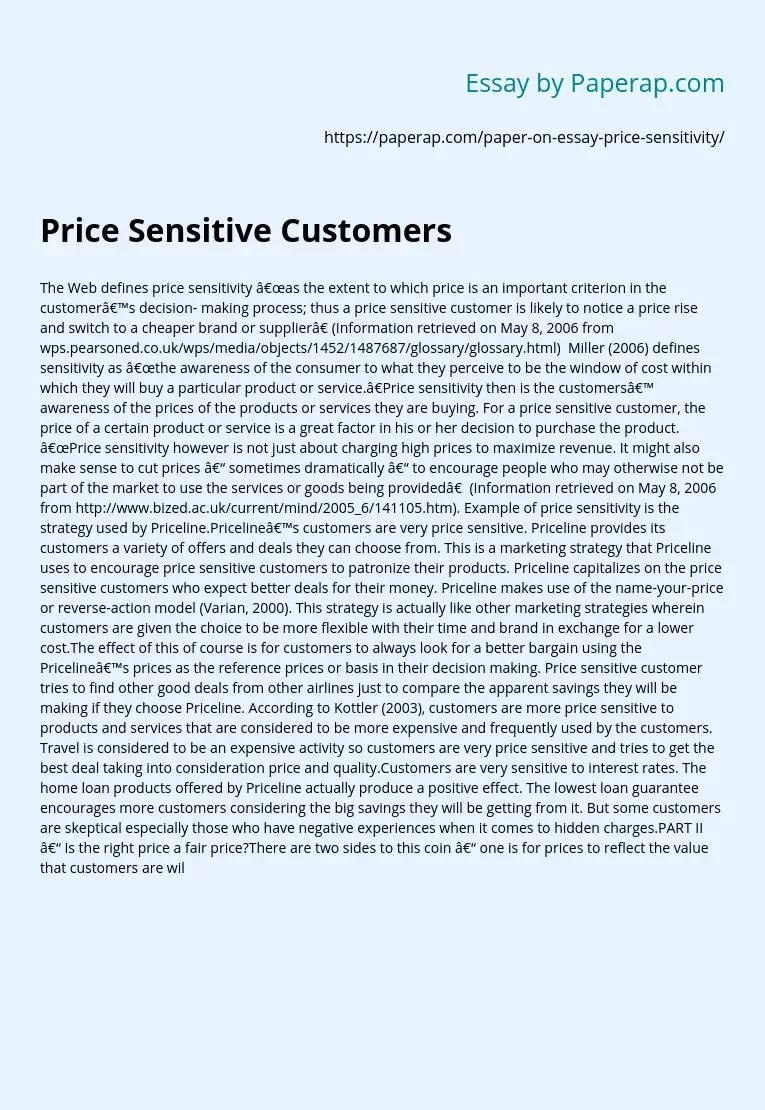Price Sensitive Customers
The Web defines price sensitivity “as the extent to which price is an important criterion in the customer’s decision- making process; thus a price sensitive customer is likely to notice a price rise and switch to a cheaper brand or supplier” (Information retrieved on May 8, 2006 from wps.pearsoned.co.uk/wps/media/objects/1452/1487687/glossary/glossary.html) Miller (2006) defines sensitivity as “the awareness of the consumer to what they perceive to be the window of cost within which they will buy a particular product or service.
”Price sensitivity then is the customers’ awareness of the prices of the products or services they are buying. For a price sensitive customer, the price of a certain product or service is a great factor in his or her decision to purchase the product. “Price sensitivity however is not just about charging high prices to maximize revenue. It might also make sense to cut prices – sometimes dramatically – to encourage people who may otherwise not be part of the market to use the services or goods being provided” (Information retrieved on May 8, 2006 from http://www.
bized.ac.uk/current/mind/2005_6/141105.htm). Example of price sensitivity is the strategy used by Priceline.Priceline’s customers are very price sensitive. Priceline provides its customers a variety of offers and deals they can choose from. This is a marketing strategy that Priceline uses to encourage price sensitive customers to patronize their products. Priceline capitalizes on the price sensitive customers who expect better deals for their money. Priceline makes use of the name-your-price or reverse-action model (Varian, 2000).
This strategy is actually like other marketing strategies wherein customers are given the choice to be more flexible with their time and brand in exchange for a lower cost.The effect of this of course is for customers to always look for a better bargain using the Priceline’s prices as the reference prices or basis in their decision making. Price sensitive customer tries to find other good deals from other airlines just to compare the apparent savings they will be making if they choose Priceline. According to Kottler (2003), customers are more price sensitive to products and services that are considered to be more expensive and frequently used by the customers. Travel is considered to be an expensive activity so customers are very price sensitive and tries to get the best deal taking into consideration price and quality.Customers are very sensitive to interest rates. The home loan products offered by Priceline actually produce a positive effect. The lowest loan guarantee encourages more customers considering the big savings they will be getting from it. But some customers are skeptical especially those who have negative experiences when it comes to hidden charges.PART II – Is the right price a fair price?There are two sides to this coin – one is for prices to reflect the value that customers are willing to pay and the other is to reflect the cost involved in making a product or service.High value item usually implies high quality. If prices are set high, customers have high expectations on the product or service. If this expectation is met by the manufacturer or the company offering the service, then high prices can still be considered a fair price.On the other hand, with the current economy of the country today and the decreasing purchasing power of many people, fair prices are prices that reflect the cost involved in making the product or service. Fair price in this case is when the customers purchase a product or service and walk away happy with the quality and the cost.Economists define fair market value as “the price that an interested but not desperate buyer would be willing to pay and an interested but not desperate seller would be willing to accept on the open market assuming a reasonable period of time for an agreement to arise” (information viewed on May 8, 2006 from http://www.investorwords.com/1878/fair_market_value.html).The concept of transparency and public accountability play important roles in setting the right price. According to Baggini (2006), a fair price in a free market is simply what the people are prepared to pay. It is considered unfair to customers if they pay inflated rates for products and services that they ended up worse off than they should have been.Products or services should be priced just enough to cover all costs incurred in its production and enough profit to sustain the producer and return on his or her investment. The interest on fluctuation and the risk of investment should also be considered in setting the right or fair price. This way, both the consumer and producer walk away happy.BIBLIOGRAPHYPART IKotler,P (2003) Marketing Management, Prentice Hall, Upper Saddle River, New JerseyMiller, L (2006). Understanding Price Sensitivity in Marketing: One of the Four Keys in the Marketing Mix. Retrieved May 8, 2006 from http://www.associatedcontent.com/article/17430/understanding_price_sensitivity_in.htmlMind your Business Price Sensitivity Retrieved May 8, 2006 from http://www.bized.ac.uk/current/mind/2005_6/141105.htmVarian, H (2000) Priceline’s Magic Show Retrieved May 8, 2006 from
Price Sensitive Customers. (2019, Dec 05). Retrieved from https://paperap.com/paper-on-essay-price-sensitivity/

